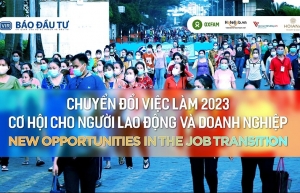Tourism could be answer for jobless
On June 16, VIR held a talk show themed “New Opportunities in the Job Transition” with a focus on finding potential areas and solutions for sustainable jobs for employees, especially workers whose jobs have been cut in the textile and footwear sectors.
 |
| There are signs that workers are keen to transition to other areas of employment, photo Chi Cuong |
At the event, Hoteljob.vn CEO Le Quoc Viet, who also runs Vieclamnhamay.vn, and said that labour recruitment demand among enterprises on Vieclamnhamay.vn has fallen to one-third, while the demand for jobs of workers has tripled, according to his websites’ statistics from April to the middle of June.
According to a survey on the opportunity and need to change jobs of workers by Vieclamnhamay.vn involving two online worker fanpages, conducted from April to mid-June with about 1,000 people, up to 83 per cent of those surveyed are unemployed. Among them, nearly 40 per cent are from sectors that are undergoing sharp cuts such as electronics, textiles, and footwear.
The survey results also showed that out of 77 per cent of workers in need of assistance in finding a job and training for new career transitions, over 40 per cent want to work in the tourism industry.
“Tourism is recovering quickly and creating an attractive job market to make up for the large loss of staff during the pandemic, although it has not yet fully recovered,” Viet commented.
The tourism industry is short of about 485,000 employees for its tourist accommodation centres, according to statistics from the Vietnam National Administration of Tourism (VNAT). It is forecasted that by 2025, the demand for accommodation workers will be more than 800,000 people and more than one million in 2030. On average, this field needs to add more than 60,000 workers each year.
“Tourism includes a variety of positions that range from entry-level to leadership roles except for management positions, other positions can be trained for a short time and can work immediately after training. It is possible to convert jobs for workers working in other fields to tourism because this industry is in a hot development stage, so it needs a lot of human resources,” said deputy director of the Hotel Department under the VNAT, Nguyen Thanh Binh.
Trinh Cao Khai, rector of Hanoi Tourism College, said that factory workers could move into the tourism sector if the transition is carefully prepared.
“Labour in the manufacturing industry has good pressure resistance and high discipline, which are necessary factors for working in the service industry,” Khai said.
“Just be ready, and after a short professional training course and a short practice time at service businesses, they can equip themselves with basic skills to enter a new profession.”
| Nguyen Hoang Ha - Programme officer, International Labour Organization in Vietnam | |
Thus, one of the important requirements is to improve the manpower’s quality and the authorities have to build an overall strategy for this work. This requirement become more urgent in the context of Industry 4.0. It is also necessary to build basic skill groups to train employees so that when they are laid off, they can apply these basic skills to a job in another sector and catch up with the other work in a short time. Another factor to improving the labour force’s quality is to create an environment for people to explore their personal capacity. | |
| Nguyen Thanh Binh - Deputy director of Hospitality National Administration of Tourism | |
Thus, increasing the quantity and improving the quality of human resources is an urgent requirement. Vietnam has become a particularly attractive destination, belonging to the group of 30 countries with the world’s leading competitiveness in terms of the tourism sector. Tourism workers need three factors: knowledge, skill, and a good attitude. Each job position from top to bottom in this sector needs particular knowledge and skills. It is possible to move people from other sectors to offset the shortage in hospitality; however, they need to be trained and practice methodically within 3-6 months. | |
| Nguyen Thu Huong - Senior programme manager Oxfam Vietnam | |
Authorities should review the effectiveness of vocational training programmes. The training courses need to be methodical, synchronised, and systematic countrywide. The vocational training facilities also need to update the recruitment market’s demand to build suitable training programmes. They have to train what the market needs instead of training what they have. For example, the current trends are green economy, automation, digital transformation, and net zero, and they should catch up with the trends to provide a suitable workforce. The collaboration between these facilities and business communities will contribute to fostering the effectiveness of training programmes. | |
| Le Quoc Viet - Founder & CEO Vieclamnhamay.vn & Hoteljob.vn | |
An effective solution is the connection of recruiters, the labour force, and vocational training facilities. We are trying to become a bridge for these parties. We also need to have solutions to help people who have been dismissed, to help access recruitment information as much as possible. We open portals to consult people, listen to them about their capacity, experience, and expectations about a new job, and then we connect them with suitable businesses. Short-term training courses which last for one month for people wanting to improve their skills and capacity designed flexibly in order that they can work half of the day and study for the remaining half. | |
| Trinh Cao Khai - Rector Hanoi Tourism College | |
We also see that workers in industrial parks often have a trend to change jobs when they are over 40 years old. There is potential for them to work in tourism and hospitality. However, it needs the readiness of labourers to join training courses as well as the readiness of businesses in these sectors. The pending issue in recruitment is the lack of connection between labourers, training facilities, and firms. If entire labourers are trained in basic skills and the connection between parties is close, taking advantage of the labour force between sectors is more feasible. |
 | Transitional support the key to protect the labour force The bleak job market and the growing number of job losses in the first half of this year has posed a challenge in supporting workers to transition into sustainable employment. |
What the stars mean:
★ Poor ★ ★ Promising ★★★ Good ★★★★ Very good ★★★★★ Exceptional
 Tag:
Tag:
Related Contents
Latest News
More News
- The destinations powering Vietnam’s festive season travel demand (December 04, 2025 | 18:33)
- Vietnam named among the world’s most exciting winter destinations (December 04, 2025 | 15:10)
- Phu Tho emerges as northern Vietnam’s new tourism hub (December 01, 2025 | 17:00)
- Vietjet completes Airbus A320/A321 updates ahead of deadline (December 01, 2025 | 09:49)
- Vietjet resumes Con Dao flights from early December (November 28, 2025 | 15:24)
- Free tickets, Lunar New Year promotions on offer at Vietjet Mega Livestream (November 26, 2025 | 15:32)
- Scandinavian Airlines and Vietnam Airlines broaden agreement with new routes (November 25, 2025 | 17:04)
- Halong Cruise Port welcomes over 3,100 international visitors (November 12, 2025 | 18:06)
- Vietnam.travel climbs to second place in Southeast Asia website rankings (November 12, 2025 | 18:01)
- Cat Ba named among Southeast Asia’s top island adventures (November 11, 2025 | 18:09)


























 Mobile Version
Mobile Version